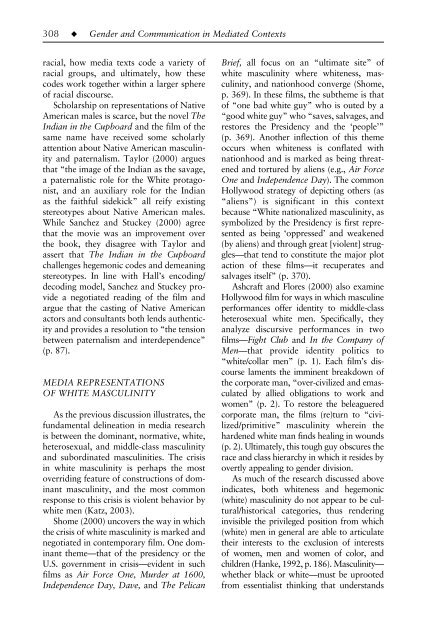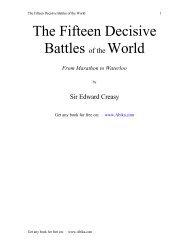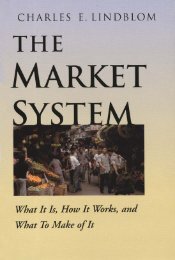Gender, race, and media representation - afghan
Gender, race, and media representation - afghan
Gender, race, and media representation - afghan
Create successful ePaper yourself
Turn your PDF publications into a flip-book with our unique Google optimized e-Paper software.
16-Dow-4973.qxd 6/11/2006 1:42 PM Page 308<br />
308–––◆–––<strong>Gender</strong> <strong>and</strong> Communication in Mediated Contexts<br />
racial, how <strong>media</strong> texts code a variety of<br />
racial groups, <strong>and</strong> ultimately, how these<br />
codes work together within a larger sphere<br />
of racial discourse.<br />
Scholarship on <strong>representation</strong>s of Native<br />
American males is scarce, but the novel The<br />
Indian in the Cupboard <strong>and</strong> the film of the<br />
same name have received some scholarly<br />
attention about Native American masculinity<br />
<strong>and</strong> paternalism. Taylor (2000) argues<br />
that “the image of the Indian as the savage,<br />
a paternalistic role for the White protagonist,<br />
<strong>and</strong> an auxiliary role for the Indian<br />
as the faithful sidekick” all reify existing<br />
stereotypes about Native American males.<br />
While Sanchez <strong>and</strong> Stuckey (2000) agree<br />
that the movie was an improvement over<br />
the book, they disagree with Taylor <strong>and</strong><br />
assert that The Indian in the Cupboard<br />
challenges hegemonic codes <strong>and</strong> demeaning<br />
stereotypes. In line with Hall’s encoding/<br />
decoding model, Sanchez <strong>and</strong> Stuckey provide<br />
a negotiated reading of the film <strong>and</strong><br />
argue that the casting of Native American<br />
actors <strong>and</strong> consultants both lends authenticity<br />
<strong>and</strong> provides a resolution to “the tension<br />
between paternalism <strong>and</strong> interdependence”<br />
(p. 87).<br />
MEDIA REPRESENTATIONS<br />
OF WHITE MASCULINITY<br />
As the previous discussion illustrates, the<br />
fundamental delineation in <strong>media</strong> research<br />
is between the dominant, normative, white,<br />
heterosexual, <strong>and</strong> middle-class masculinity<br />
<strong>and</strong> subordinated masculinities. The crisis<br />
in white masculinity is perhaps the most<br />
overriding feature of constructions of dominant<br />
masculinity, <strong>and</strong> the most common<br />
response to this crisis is violent behavior by<br />
white men (Katz, 2003).<br />
Shome (2000) uncovers the way in which<br />
the crisis of white masculinity is marked <strong>and</strong><br />
negotiated in contemporary film. One dominant<br />
theme—that of the presidency or the<br />
U.S. government in crisis—evident in such<br />
films as Air Force One, Murder at 1600,<br />
Independence Day, Dave, <strong>and</strong> The Pelican<br />
Brief, all focus on an “ultimate site” of<br />
white masculinity where whiteness, masculinity,<br />
<strong>and</strong> nationhood converge (Shome,<br />
p. 369). In these films, the subtheme is that<br />
of “one bad white guy” who is outed by a<br />
“good white guy” who “saves, salvages, <strong>and</strong><br />
restores the Presidency <strong>and</strong> the ‘people’”<br />
(p. 369). Another inflection of this theme<br />
occurs when whiteness is conflated with<br />
nationhood <strong>and</strong> is marked as being threatened<br />
<strong>and</strong> tortured by aliens (e.g., Air Force<br />
One <strong>and</strong> Independence Day). The common<br />
Hollywood strategy of depicting others (as<br />
“aliens”) is significant in this context<br />
because “White nationalized masculinity, as<br />
symbolized by the Presidency is first represented<br />
as being ‘oppressed’ <strong>and</strong> weakened<br />
(by aliens) <strong>and</strong> through great [violent] struggles—that<br />
tend to constitute the major plot<br />
action of these films—it recuperates <strong>and</strong><br />
salvages itself” (p. 370).<br />
Ashcraft <strong>and</strong> Flores (2000) also examine<br />
Hollywood film for ways in which masculine<br />
performances offer identity to middle-class<br />
heterosexual white men. Specifically, they<br />
analyze discursive performances in two<br />
films—Fight Club <strong>and</strong> In the Company of<br />
Men—that provide identity politics to<br />
“white/collar men” (p. 1). Each film’s discourse<br />
laments the imminent breakdown of<br />
the corporate man, “over-civilized <strong>and</strong> emasculated<br />
by allied obligations to work <strong>and</strong><br />
women” (p. 2). To restore the beleaguered<br />
corporate man, the films (re)turn to “civilized/primitive”<br />
masculinity wherein the<br />
hardened white man finds healing in wounds<br />
(p. 2). Ultimately, this tough guy obscures the<br />
<strong>race</strong> <strong>and</strong> class hierarchy in which it resides by<br />
overtly appealing to gender division.<br />
As much of the research discussed above<br />
indicates, both whiteness <strong>and</strong> hegemonic<br />
(white) masculinity do not appear to be cultural/historical<br />
categories, thus rendering<br />
invisible the privileged position from which<br />
(white) men in general are able to articulate<br />
their interests to the exclusion of interests<br />
of women, men <strong>and</strong> women of color, <strong>and</strong><br />
children (Hanke, 1992, p. 186). Masculinity—<br />
whether black or white—must be uprooted<br />
from essentialist thinking that underst<strong>and</strong>s




